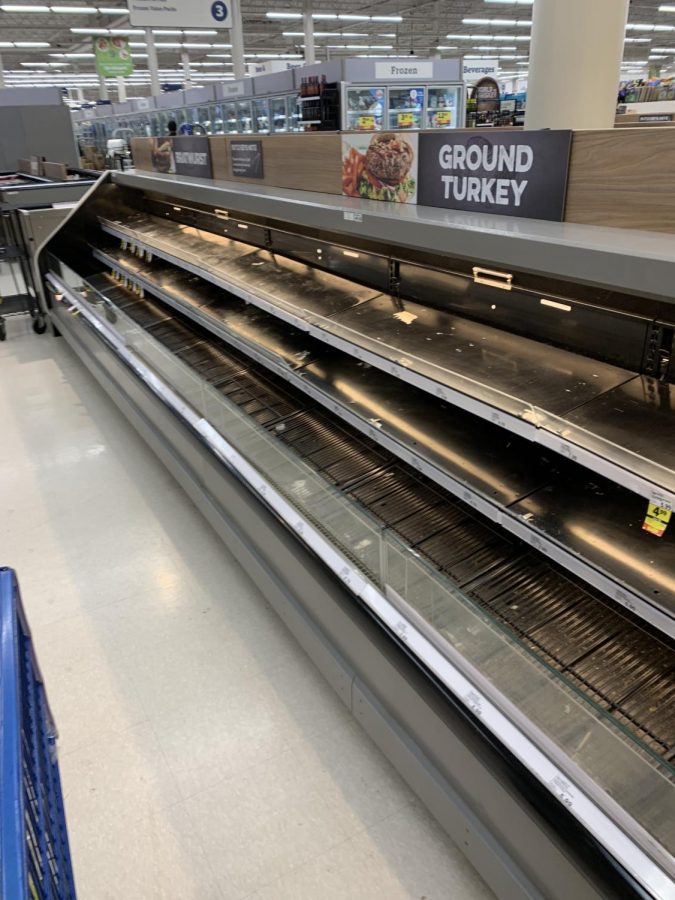COVID-19 impacts U.S. Food Supply
For the last 2 months, many grocery stories have had a difficult time keeping meat, dairy and other produce items stocked. This picture, from March, shows a Meijer store that is sold out of ground turkey.
May 14, 2020
Having a steady stream of updates through constant COVID-19 media coverage has prompted numerous reactions from audiences worldwide, with many people being fearful, anxious, or upset hearing of the traumatic experiences coming from a virus’ spread. Between a high death toll across borders to dismaying videos of poverty’s impact on those in need, it isn’t unusual for someone to feel angered or sad by the majority of news today.
One such example encompasses the food supply chain in the United States; thousands of posts and articles have shared the horrifying excess of crops and dairy products, like milk, being left to spoil–but why?
With so many organizations fighting to ensure food security for impoverished individuals, it’s hard to imagine a justifiable reason to waste such precious goods. Despite the widespread efforts to reduce the long-term effects of COVID-19 on millions of people, one lasting imprint will be made on the food available to people everywhere as the agriculture industry fights to stay afloat for the sake of all Americans. As best stated by American Farm Bureau Federation President Zippy Duvall, “Empty shelves can be frightening, but empty barns and fields would be devastating.”
The first question that many people have circles the controversy of content found online, such as dozens of gallons of milk being dumped for seemingly no reason. The largest issue for commercial farmers at this time is not in producing goods to sell or donate, but rather transporting products safely over long distances. A surplus of dairy has become a common phenomena in many regions where agriculture is a sustainable way of life, like in the Midwest. As explained by Zoey Nelson, a dairy farmer in Wisconsin, “You can’t shut down cows. You can’t turn them off like a faucet.”
Another contributing factor is the vast scale of dairy products usually consumed in school buildings and restaurants that are no longer in daily use. Lunch programs and businesses across the country spend millions on milk, butter, cheeses, and other manufactured dairy products, all of which are being purchased for lesser quantities for supermarkets to reduce waste and panic buying.
In an attempt to combat the issue, hundreds of organizations, like Feeding America, promote ways for people to contribute to the cause individually, but when it comes to large-scale donations, it can be far more difficult to facilitate aiding those in need. Particularly in areas hit the hardest by infection, it can be dangerous for staff to distribute or transport food.
The meat industry is another that has been greatly affected by COVID-19 cases; large corporations have been forced to shut down amid a sharp increase in infections of plant employees. John Tyson, Chairman of Tyson Foods, released a statement on April 26th explaining how these closures will lead to meat shortages and price jumps for consumers around the United States.
As a result of restaurant chain and school closures, minimal tourism and travel, and panic buying, many are afraid of what grocery shopping will look like in the months to come. This comes as no surprise, as according to the U.S. Department of Agriculture, 54.4% of consumer food expenses in 2018 went toward eating outside of the home.
Though the supply of each product varies greatly by location and proximity to production hot-spots, it goes without saying that prices for most perishable goods will rise in response to increased demand. This will likely include fruits, vegetables, grains, dairy, meat, and even flowers. Countries around the world are frantically finding temporary solutions to maximize goods normally exported in large amounts, like potatoes in Belgium, and flower bulbs in the Netherlands. This can be expected until more answers are found for the state of COVID-19 and stability slowly returns.
The unknown nature of the United States’ food supply–as well as that of dozens of other nations–is an unsettling topic during this time, especially as neighbors in all communities may be faced with food, financial, employment, and health threats. As professionals and essential workers continue to fight as the infantrymen against the virus, support those around you as much as possible, and stay optimistic for the day that common consumer goods will be readily available on the shelves once more.
